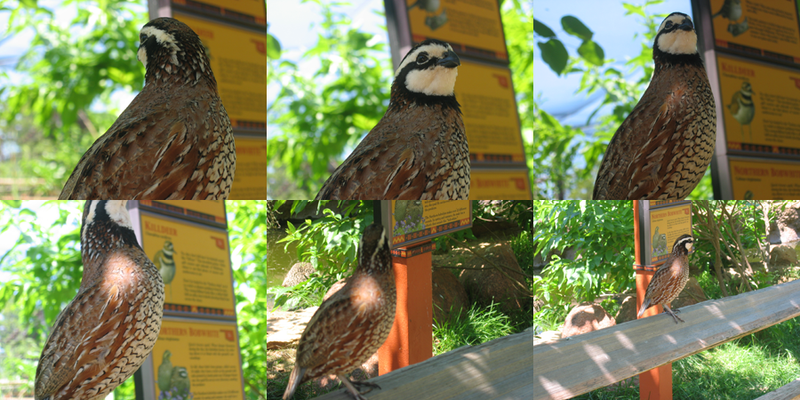Interactions
All living organisms interact with each other constantly. These interactions could be positive such as a mutualistic relationship or negative as in parasitism. Organisms can also be prey, predators, or even both. Regardless, of the interaction no species would be able to live without them. The bobwhite quail is no exception from this rule and it interacts in its community all the time. This page will show how it interacts with other organisms.
If you were to go to a habitat in which the Bobwhite quail is found, you would most likely see many different types of plants and animals such as:
Plants:
 The bobwhite quail's diet, as mentioned on the
Nutrition page is mostly seeds and
fruits. These seeds and fruits come from many plants found in its
habitat. Some plants that quails could acquire food from would be pine trees, oak trees, black
berry bushes, grab grass, thistles and clover. This makes all the
plants I have just listed prey of the bobwhite quail.
The bobwhite quail's diet, as mentioned on the
Nutrition page is mostly seeds and
fruits. These seeds and fruits come from many plants found in its
habitat. Some plants that quails could acquire food from would be pine trees, oak trees, black
berry bushes, grab grass, thistles and clover. This makes all the
plants I have just listed prey of the bobwhite quail.
But plants aren't only prey for these birds to feed on. In fact the bobwhite quail uses pine trees, grass, blackberry bushes, and even sumacs shrubs as a shelter and a place to live.
Animals:
Not only is the bobwhite quail a primary consumer, but it is also a secondary consumer. Some of the animals that this bird preys on are: spiders, beetles, snails, grasshoppers, and millipedes. Who would have thought that quails have such a diverse diet?
Although these birds may prey on a lot of other organisms, they too may find themselves as prey. Some of their predators include: foxes, possums, hawks, owls, snakes, and squirrels. Theses predators dont only eat adult quails, but also destroy many of their nests and eat their eggs. Bobwhite quails are prey to so many organisms that their life expectancy is usually less than a year!! It is also said that chick mortality is around 1-2 weeks after their hatching.
Click the link to see more animal and plant Relationships.
Parasitism:
Interactions not only occur outside in the visible world, but also inside other organisms. Some interactions may be beneficial, like bacteria that resides in their guts and intestinal tracts. Others can be harmful in the case of parasitism. Flat worms, round worms, and even protozoans can be found living inside the bobwhite quail. Although these organisms feed off of these quails, no evidence has been collected to show that the bobwhite quail has been killed by parasitism. This is because quails badly infected by these parasites usually get sick and are quickly preyed upon by predators. It is also rare to find dead quails to study in nature because they are consumed shortly after death.
Human Interaction:
Humans have been hunting the bobwhite quails in the Americas for
as long as the Native Americans have lived in their lands. Native
Americans used these quails for their meat, pelts, feathers, and
even bones. But early European settlers did not usually hunt these
quail because an efficient gun for bird hunting had not been invented.
Instead these quails were trapped for their pelts and meat. Despite
all these human interactions, the bobwhite quail didn't face huge
population loses.
It wasn't until 1940 that the quail population really started to decrease. This was not due to excessive hunting, but from destruction or alteration of their habitat as you learned about in the Habitat page. The decrease in the quail population is not only a problem for bird watchers and scientists that want to study this magnificent bird, but also for hunters who enjoy to hunt the bobwhite quail for meat. This bird will remain a sustainable food source only if humans do not destroy all of their natural habitats and do not over hunt them.
Quick head over to the Facts page to learn some thing you probably never knew about the bobwhite quail.
